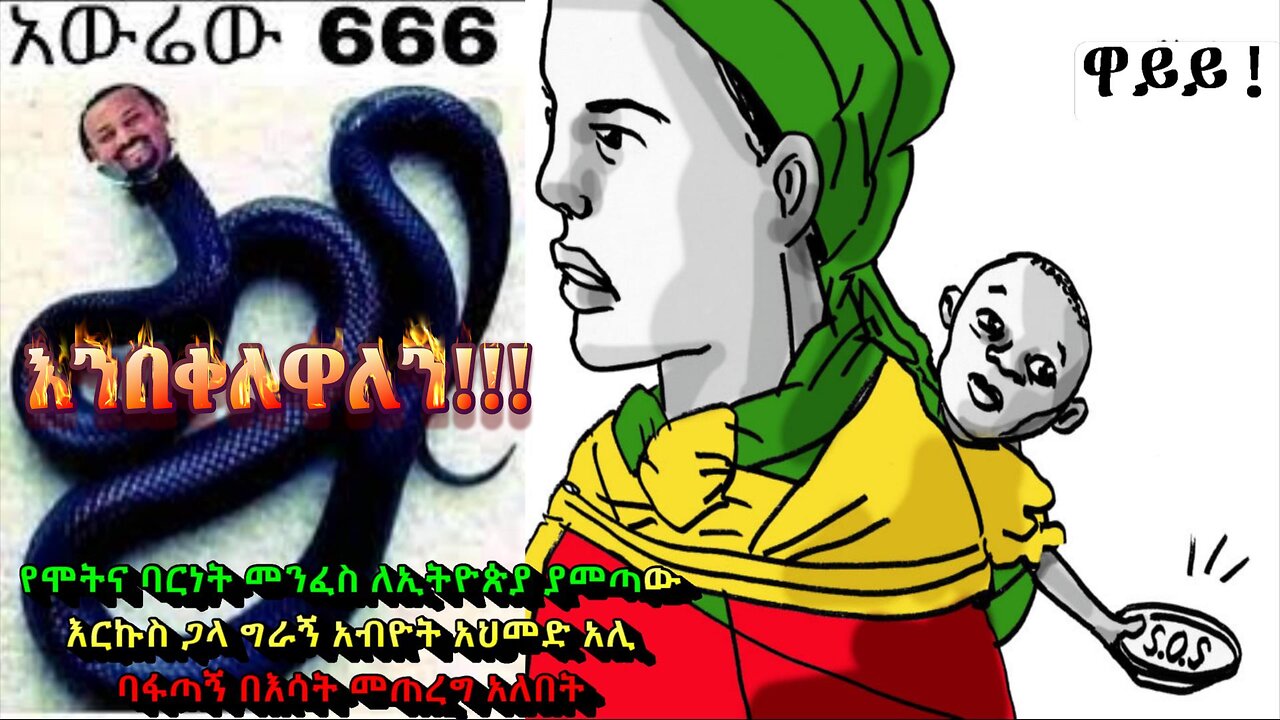Premium Only Content

Ethiopia: The Weaponized Womb: Mapping Reproductive Violence as a Tool of Ethnic Cleansing
👉 Courtesy: New Lines Institute, by Klara Vlahčević Lisinski, Washington D.C., October 14, 2025
The genocidal war in Ethiopia’s Tigray region, which erupted in November 2020 between the Tigray People’s Liberation Front and a coalition of Ethiopian federal forces, Amhara regional militias, and Eritrean troops, quickly devolved into one of the most brutal and under-reported humanitarian crises of the decade. At the center of this violence was a gendered campaign of terror: widespread and deliberate sexual and reproductive violence (SRV) targeting Tigrayan women and girls. This violence was not incidental to the conflict but formed a strategic axis of ethnic cleansing, deployed through the systematic destruction of women’s bodies, reproductive autonomy, and societal roles.
As Ethiopian and Eritrean troops advanced into Tigrayan towns and villages, women became targets of extreme brutality. Survivor testimonies collected in displacement camps and medical clinics describe a pattern of sexual violence marked by rape, gang rape, forced impregnation, sexual slavery, genital mutilation, and sterilization. These acts followed military incursions with haunting regularity, particularly in places like Humera, Adigrat, and Shire. Women were often told during their assaults that they were being “punished” for their ethnicity and that their wombs would be “cleansed” of Tigrayan blood – a chilling articulation of intent that was repeated in numerous survivor accounts.
SRV committed by armed combatants in Tigray is characterized by its scale, coherence, brutality, and unmistakable ethnic and gendered intent. The female body was weaponized as a battleground to extinguish the reproductive capacity of an ethnic group and shatter the cohesion of its communities. In countless cases, rape was paired with physical mutilation that left survivors infertile, disabled, or suffering chronic pain. Forced pregnancies were not only tolerated by occupying forces; they were part of the message. In many instances, access to emergency contraception or abortion was deliberately denied, and the denial of post-rape care was used as a tactic to deepen harm.
The consequences for survivors extend well beyond the battlefield. Many women now face lifelong trauma compounded by stigma, rejection by their families, or forced parenthood of children born of rape. In Tigrayan culture, as in many others, sexual violence carries immense social stigma, further isolating victims and silencing their stories. The psychological damage of these crimes is deepened by the lack of medical care, social services, or avenues for justice. Women and girls displaced by the conflict, both internally within Ethiopia or across borders, suffer quietly, navigating chronic pain and shame in isolation.
The New Lines Institute report “Conflict-Related Sexual and Reproductive Violence in Tigray” identifies a clear geographic and temporal correlation between the advance of Ethiopian and Eritrean forces into Tigrayan territories and the occurrence of SRV. As these forces moved into new areas, reports of mass rape, genital mutilation, and forced sterilization surged. This pattern suggests that SRV was not merely a byproduct of war, but a strategic tool employed to achieve military and political objectives.
The use of SRV in Tigray aligns with patterns observed in other conflicts where rape has been recognized as a tactic aimed at destroying an ethnic group, such as in Bosnia and Rwanda, demonstrated that this was not an isolated atrocity but rather a symptom of gendered power structures that persist in conflicts worldwide. Despite this, international justice systems remain ill-equipped to address gendered genocidal strategies effectively. The slow pace of legal recognition, under-resourced mechanisms for documenting SRV, and the lack of survivor-centered accountability processes hinder efforts to bring perpetrators to justice. The Tigray case illustrates how mass sexual violence can be systematically deployed with the intent to destroy an ethnic group, yet remain underrecognized as an act of genocide, despite overwhelming qualifying evidence.
Impunity for these crimes cannot be separated from the way women’s experiences are often sidelined in post-conflict justice and policy. In Ethiopia, there is little political will to prosecute SRV cases, especially those implicating state actors. Survivors who come forward risk harassment, retaliation, or re-traumatization. Without international intervention and survivor-centered frameworks, most perpetrators will not be held to account – and most survivors will go unheard.
Addressing this requires more than legal innovation. It requires reimagining justice and recovery through a gendered lens. That begins with recognizing that SRV is not a side effect of war, but a method of warfare that specifically targets women’s bodies, choices, and futures. Reparative systems must prioritize not only legal accountability but also comprehensive physical and psychological care. Ensuring that survivors receive comprehensive and sustained support – not only in the immediate aftermath but throughout their long-term recovery – must be a key priority of any meaningful transitional processes. Efforts to rebuild Tigrayan society must involve survivors at the center, not on the margins.
Documentation is another critical front. The report notes that real-time evidence gathering was hampered by blackouts, displacement, and stigma. Many survivors did not – or could not – seek help in time for their injuries to be recorded, while others feared the social cost of speaking. Moving forward, civil society organizations need the tools and funding to document SRV safely and confidentially, even during conflict. Survivors must be empowered, not retraumatized, by this process.
Prevention, too, requires gendered foresight. SRV does not erupt in a vacuum; it is preceded by warning signs: dehumanizing propaganda, militarization of civilian spaces, impunity for prior sexual crimes, and nationalist ideologies that fuse ethnic purity with control over women’s reproduction. These indicators must be integrated into early warning systems and peacekeeping mandates. Gender-based atrocity should never again catch the international community by surprise.
-
![MAHA News [10.17] Fertility Crisis, Redoing Vax Schedule, Psychiatry Corruption, Vegan vs Carnivore](https://1a-1791.com/video/fwe2/78/s8/1/Q/v/s/r/Qvsrz.0kob-small-MAHA-News-10.17.jpg) LIVE
LIVE
Badlands Media
14 hours agoMAHA News [10.17] Fertility Crisis, Redoing Vax Schedule, Psychiatry Corruption, Vegan vs Carnivore
551 watching -
 LIVE
LIVE
Owen Shroyer
1 hour agoOwen Report - 10-17-2025 - President Trump And Zelensky Take Questions At The White House
1,351 watching -
![[Ep 772] No Kings for Weak Minds: Funding & Following | CA Homelessness: Crisis & Scandal](https://1a-1791.com/video/fww1/d8/s8/1/g/j/B/r/gjBrz.0kob-small-Ep-772-No-Kings-for-Weak-Mi.jpg) LIVE
LIVE
The Nunn Report - w/ Dan Nunn
2 hours ago[Ep 772] No Kings for Weak Minds: Funding & Following | CA Homelessness: Crisis & Scandal
181 watching -
 1:18:31
1:18:31
The Culture War with Tim Pool
4 hours agoTim Pool Vs. Liquid Death CEO DEBATE
109K123 -
 LIVE
LIVE
Times Now World
18 days agoLIVE Jeffrey Sachs | Netanyahu Turned U.S. Military Into His Own War Machine | Times Now World
46 watching -
 LIVE
LIVE
ahdedazs
1 hour agoARC Raiders Playtest! *Multistreaming*
16 watching -
 1:58:33
1:58:33
The Quartering
4 hours agoCrowder Roasts Entitled Black Man, Hasan Piker Meltdown, Leftoid Instant Regret!
37.2K38 -
 1:03:29
1:03:29
DeVory Darkins
4 hours ago $30.44 earnedKash Patel drops DEVASTATING NEWS for Democrats as ANTIFA suffers MAJOR LEGAL BLOW
80.2K118 -
 59:37
59:37
Jeff Ahern
2 hours ago $0.01 earnedFriday Freak out with Jeff Ahern
10.3K2 -
 1:14:56
1:14:56
Lara Logan
15 hours agoTHE ONLYFANS SCAM: Victoria Sinis Breaks Down the Dangers and Lies Targeting Your Children | EP 40
47.4K9